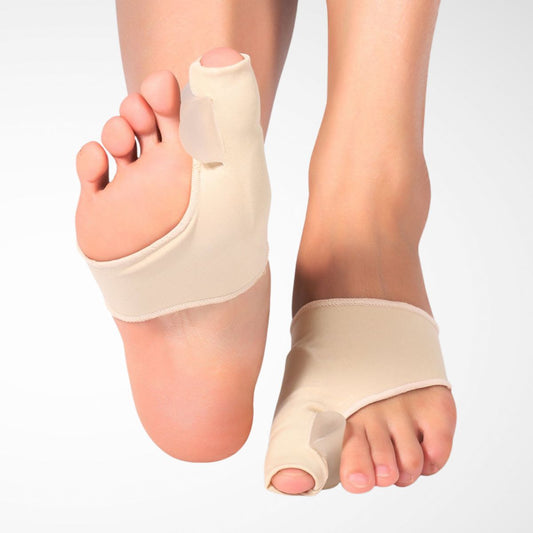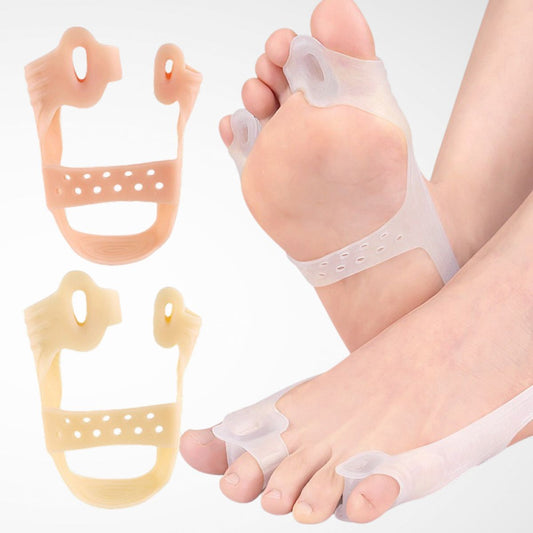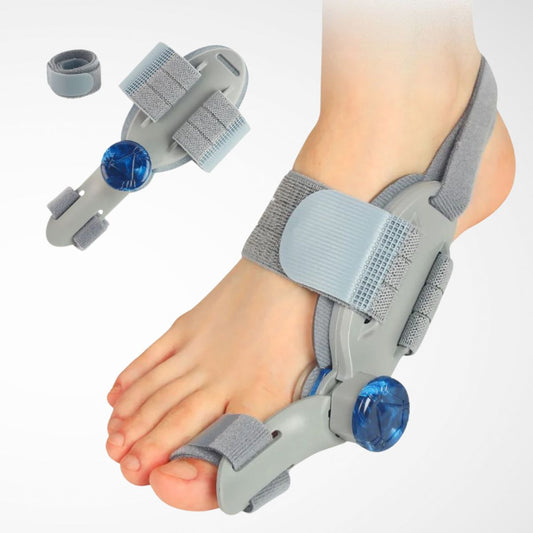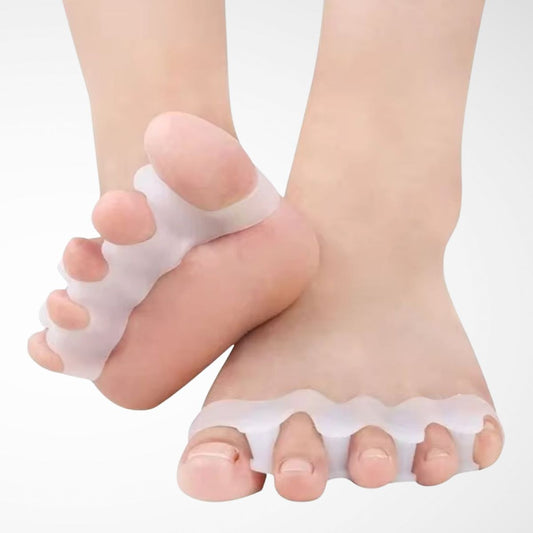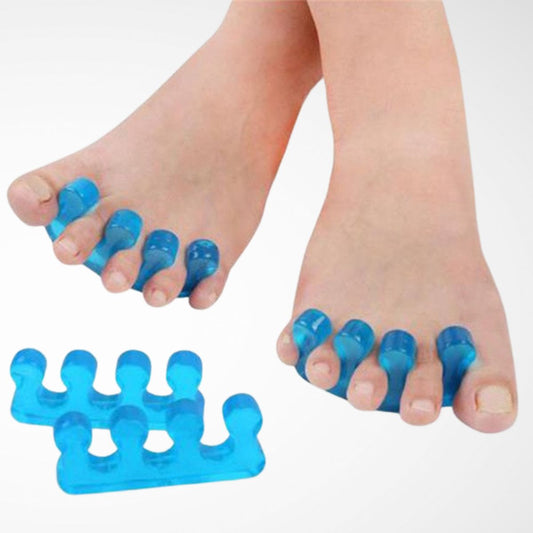-
FeetRight® Bunion Corrector Sleeves (Pair)
Regular price $14.99Regular priceUnit price per$29.99Sale price $14.99Comfortable and slim-fitting, these bunion sleeves feature a soft silicone pad to cushion and realign the big toe. Can be worn with socks and inside most shoes for all-day relief without the bulk. Ideal for mild to moderate bunion pain.
Sale -
BetterSpine™️ Bunion Correcting Toe Spacers (Pair)
Regular price $17.99Regular priceUnit price per$29.00Sale price $17.99All-in-one flexible support for both bunion and tailor's bunion (bunionette). These slim, skin-friendly toe spacers fit easily in socks or shoes and stay secure thanks to textured grips and flexible bands.
Sale -
Adjustable Bunion Corrector Splint
Regular price From $29.00Regular priceUnit price perProfessional-grade correction with a 180° rotatable toe knob and secure Velcro straps. Breathable and durable, ideal for bunion alignment with firm and customizable support during sleep, rest, or light activity.
-
Comfort Align Toe Spacers (Pair)
Regular price $14.99Regular priceUnit price perSeparates all five toes to relieve bunions, overlap, and misalignment. Supports overall foot health—soft, flexible, and ideal for posture, balance, recovery, yoga, or daily wear.
-
Pedicure Toe Separators (Pair)
Regular price $12.00Regular priceUnit price perFirm, structured separators designed for pedicures and mild toe alignment. Holds toes apart to simplify nail care and reduce overlap during rest. Easy to clean and reusable.
Supporting You Starts Here:
Your Bunion Care Questions, Answered.
What is a bunion, bunionette, or tailor's bunion?
A bunion (hallux valgus) is a bony bump that forms at the base of the big toe due to joint misalignment, often pushing the big toe inward toward the other toes. This can lead to swelling, pain, and difficulty wearing certain shoes.
A tailor’s bunion (bunionette) is similar but occurs on the outside of the foot at the base of the pinky toe. Their treatment options are usually similar to that of a bunion's.
Both conditions are often caused by genetics, poor footwear (tight, narrow shoes), or mechanical imbalances in the feet. Over time, they can lead to pain, stiffness, increased pressure on surrounding toes, and sometimes, indirectly causing other complications such as poor gait, neuropathy or sciatic pain.
Do bunion correctors really work? How long does it take?
Bunion correctors do not reverse the bunion bone structure, but they can offer real relief, help with alignment, and may slow or stop the the progression of bunions — especially when used consistently and combined with proper footwear.
While there's insufficient clinical evidence of full correction, there are many people who reported reduced pain and better toe alignment after regular use.
Some people notice relief within the first few weeks, while alignment changes (if any) typically require several weeks to a few months of steady use.
For more insight on this topic, please visit:
How Long Does It Take for a Bunion Splint to Correct Your Toe?
What is the best bunion corrector for my condition?
It depends on your needs:
- For pain relief and/or gentle realignment: Try a cushioned sleeve or toe spacer to reduce rubbing and pressure from poor toe alignment.
- For sleep and realignment: A rigid splint provides structured support.
- For balance and posture: Full-foot toe spacers help realign your base — ideal for yoga, barefoot training, or after workouts.
- For mild support during the day: Consider a soft bunion sleeve for discreet, low-profile wear.
Still unsure? Learn how to choose the right bunion corrector for you.
What’s the best bunion corrector to wear with shoes? What shoes should I wear if I have bunions?
For shoe compatibility, look for low-profile bunion sleeves or toe spacers that don't take up much space. Be mindful of what kind of support you need (such as big toe alignment or pinky toe alignment, or both), and what kind of support they are designed for.
Both bunion sleeve and toe spacers are flexible and can be worn inside wide-toe box shoes or sandals. Avoid wearing rigid bunion splints with shoes — they’re best for rest.
To choose a good footwear for your bunions, we recommend:
- Shoes with wide toe boxes
- Soft, breathable uppers (e.g., mesh or knit)
- Arch support and low heels (avoid stilettos or narrow loafers)
Check out our full blog: Shoes for Bunion Feet: What to Look For + Top Picks
What’s the difference between bunion correctors, splints, sleeves, toe spacers, and separators?
These terms are often used interchangeably, but they serve different purposes:
- Bunion correctors is a broad term that includes any device used to relieve bunion pain or encourage toe realignment.
- Bunion splints are typically rigid or semi-rigid devices that provide structured support to hold the big toe in place. They’re often worn during sleep or rest periods.
- Bunion sleeves are soft, stretchy fabric that cushion around the bunion and reduce friction inside shoes. Not all sleeves include gel padding between the big toe and second toe to help with gentle alignment, but those that do often provide more benefits. They’re ideal for daytime wear—especially inside shoes—offering comfort and mild support without bulk.
- Toe spacers are designed to separate and realign the toes. Some are soft and flexible for use in shoes, while others are firmer and better for recovery or barefoot wear. Read about their benefits here.
- Toe separators are often used interchangeably with toe spacers. However, they are usually used for temporary relief — such as during pedicures or light home use — and offer gentle toe separation without significant corrective support.
Each has its own strengths, and many people rotate between them depending on activity, footwear, and pain level.
Should I get bunion surgery? What are non-invasive options?
Bunion surgery is generally considered when:
- Pain interferes with daily life
- Bunion deformity is severe
- Non-surgical options have failed
However, most people with mild to moderate bunions can manage symptoms non-invasively using:
- Corrective devices: Bunion splints, spacers, sleeves
- Footwear changes: Wide, bunion-friendly shoes
- Foot exercises: To strengthen foot muscles
- Lifestyle adjustments: Reduce high-heel or narrow shoe use
As always, we recommend consulting a qualified healthcare provider or podiatrist to assess your condition and guide you on the most suitable approach for your needs.
Can I wear a bunion corrector all day or during sleep?
Generally, yes — many bunion correctors are safe for extended wear. But it depends on the type of corrector and your activity level:
- Toe spacers and bunion sleeves: These are often soft and flexible, making them suitable for daily wear, walking, or even light activity like yoga. Just make sure they’re not too tight and don’t cause skin irritation.
- Rigid bunion splints: These provide stronger corrective force and are best worn during rest or sleep. They’re not designed for walking or movement.
- Toe separators: These are ideal for short periods of use — such as post-workout recovery, lounging, or relaxing at home — but not meant for wearing inside shoes.
It’s best to start with 1–2 hours a day and gradually increase wear time as your feet adjust. Keep an eye out for discomfort, redness, or chafing — these are signs to take a break or switch to a gentler option.
Sometimes, wearing a bunion corrector all day isn't necessary or helpful. For a deeper breakdown on wear time and how to read your body's signals, check out our full guide here.

